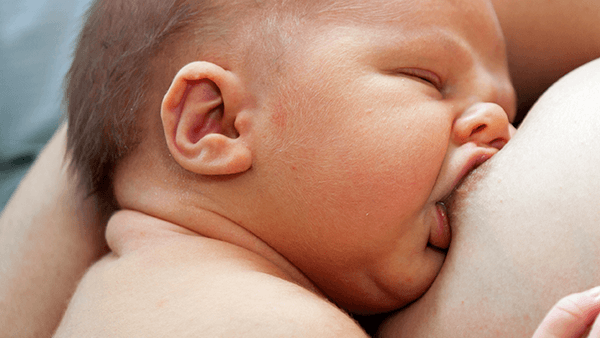Getting the baby to latch on to the breast
It is important that the baby can latch on to the breast properly as this will reduce the risk of sore nipples, uncomfortable breastfeeding, engorgement, insufficient amounts of milk and slow weight gain in the baby.
Read time: 3 m
Verified by Ingela Ågren
Certified Midwife
Breastfeeding will be most effective when the baby takes a big mouthful of both nipples and areola. It might take some time for the baby to latch on and for the mother to find a good feeding position. The baby can be breastfed in many different positions, so make sure to find one that is comfortable for you. Some women prefer to lay down, while others want to sit or half-sit. Most important is that you can relax and that you don’t create tension in your body. If you are sitting, try using some pillows under the baby or under your arms to avoid straining your muscles.

Things to be aware of regarding feeding position:
- Keep the baby close, with the baby’s tummy against yours. The baby should not have to turn his/her head to latch on to the breast.
- Support the baby’s neck, shoulder and upper back with one hand.
- Move the baby to the breast, not the other way around, as this creates unnecessary pulling on the nipple.
- The nipple should be positioned just over the baby’s upper lip.

Once the baby is in position, is ready to feed and has his/her mouth open wide, then move the baby to the breast. Both nipple and areola should be inside the baby’s mouth. Ensure that:
- The baby’s chin is touching the breast and the nose is not covered so the baby can breathe.
- The baby’s lips are turned out.
- The cheeks are round and not retracted, which may be a sign the baby is not latched on properly.
It’s common for new mothers to feel a little soreness or tenderness with breastfeeding, especially in the very beginning. This will pass. If it doesn’t, this may be a sign the baby is not latched on properly. If it is painful, or if you need to interrupt breastfeeding for some other reason, carefully insert a finger into the corner of the baby’s mouth. Air will enter and the baby will let go of the breast and you can start all over. Don’t let the baby continue if you feel it hasn’t latched on properly.
Examine the nipple before and after breastfeeding. The nipple should be round and pointed at the baby after feeding. This is an indication the baby has been latched on properly. If the nipple is squashed or pointing to the side, this means the baby has been latched on incorrectly or been in the wrong position.
Verified by Ingela Ågren
Certified Midwife
More from Preggers
Hundreds of related articles, podcasts & more waiting for you in the Preggers app.
Download Preggers today.

